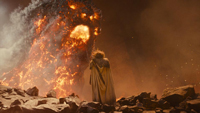
Visual effects supervisor Olivier Dumont coordinated the work of Method in London and LA on ‘Wrath of the Titans’. The two teams constructed the complex, cavernous environment and fiery volcanic effects of the underworld, Tartarus, and built and animated the huge god Kronos.
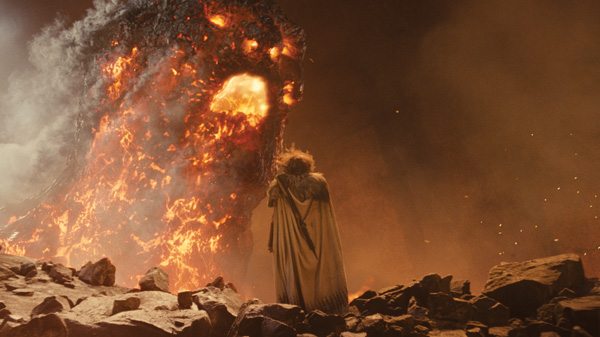 |
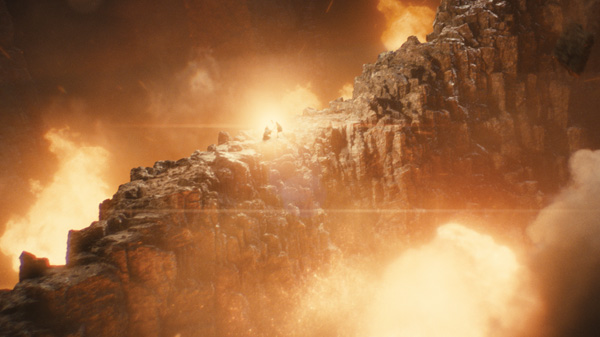 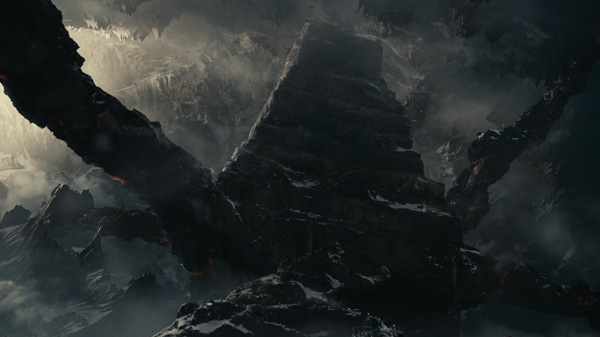 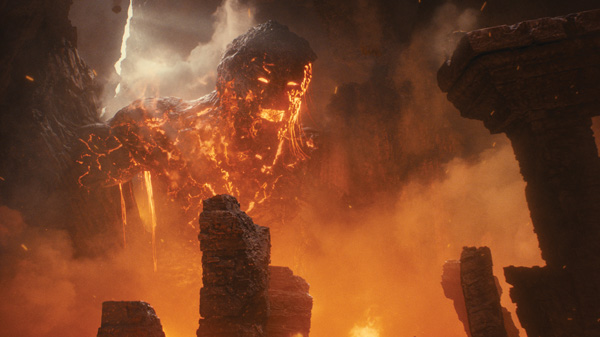 |
| The London team was contacted early in production to help develop concepts. Although the Art Department was large and major assets such as the tower of Tartarus, a double tower floating in the middle of the underworld, had been well-designed in pre-production, the Method team needed to plan the wide shots within this huge space and build the layout of the environment into the scenes
Olivier and the team followed a structured approach. “We first removed and replaced the greenscreen with the basic shapes that would be used across all the sequences in order to get approval before proceeding, and set up the composition and framing,” he said. “From there, we had more freedom to develop the look and details of the models they would need to incorporate.” Scale and Distance Olivier used the reference first to prepare documentation for Nick Davis and director Jonathan Liebesman to show them how they would recreate and extend the sets into the massive interior of Tartarus. Kronos, the fiery leader of the Titans and Zeus’ father, was about 500m tall and Tartarus itself was some 5,600km high. It encompasses the tower, an island and a bridge leading to Kronos and the mountains where he is embedded. Among their principle challenges and ongoing concerns was representing that scale and distance on screen while balancing the size with the level of detail and atmospherics. The shoot was just beginning when Olivier arrived for on-set supervision in early March 2011. Because the environment appears several times in the movie, it was shot early in production. Creatively, it was an interesting time to be there because many decisions remained to be finalised about looks, giving him a chance to work with the Art Department. They were testing, for example, how much the atmosphere could be enhanced with visual effects because shooting on greenscreen prevents the use of dust, smoke and particles on set. |
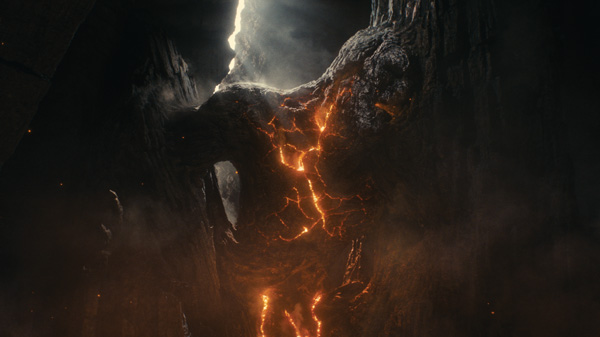 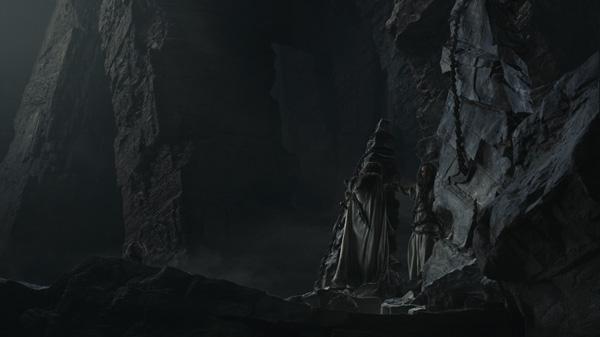 |
| Managing Detail Once the scans began arriving at Method LA and London studios, post production proceeded at a fast pace, to be completed in less than six months. Method covered their shots with a team of 110 people in the two locations. Modelling and texturing the stone blocks was done mainly with ZBrush, which is quite fast to work with when producing organic looks and detailing. Olivier explained, “Due to the size of the environment and the varied camera angles, the team had to provide enough detail to handle a fly-through. For Kronos and the mountains adjacent to him, the artists needed to split the models into more manageable sizes allowing them to increase the level of detail when necessary. For other less demanding sections, we could build blocks or clusters of rock, combining them randomly at first and then working on them by hand to achieve precise shapes and textures. “For the island and inner walls of Tartarus, they ended up modelling over 7,000 pieces. Once this work was approved, they needed to merge these pieces to be able to be able to render the images while ensuring the textures would still work. Then at that stage we could address the lighting.” The traditional approach to lighting – that is, mimicking the live action plates – was inadequate in this environment. They had to design and create lighting scenarios for their sequences that would further the story and drama, for example by deliberately darkening or brightening shots as required. For instance, the artists used the delay and fall-off of light from the flashes of lightning they created in the final destruction sequence to help indicate the magnitude of the interior of Tartarus. They also experimented with the huge crack behind Kronos, contrasting the cool light shining through it with the warm light from the fire and embers. Light and Re-Light “The atmospherics were also important to express the vast space, and involved several approaches to handle dust, smoke and particles associated with the fire, embers and, most significantly, lava and pyroclastics. To be able to cover the variation and save time, our strategy was to involve the compositing department as early as possible. They mocked up the shots with 2D elements, plus the camera moves, just to get approval at that stage to help them determine the quantity and speed of the elements for each shot.” This technique allowed them to achieve very quick turnovers. They used some of their own library elements, some that Nick had shot during the shoot and other generic CG elements that couldn’t readily be shot like giant boulders falling in the background. Once they had approval they could define what they would be able to keep as 2D by observing what was breaking under the approved camera moves and what would look better as a CG element. Some elements, especially the embers, had to be animated in a special way that required 3D CG, for example. Thus, the 2D mock-ups helped both the team and the production. 3D Ride Though the approach was similar to the other rock interiors, the rock had a much more organic design and texture, and needed different references. The 3D scans of the original quarry helped construct the environment realistically. Early previs has the shot starting in a more open space with branches extending into the earth but later it developed with the camera hurtling down a long, narrow heavily textured crack. Transitioning Simulations “The artists were using a simulation that did produce a realistic animation but, in order to preserve the detail in the lava, it was difficult to access enough render power to run more than two tests on their set-ups. So, for reach one, they had a simulation driving the animation of a sculpt of the lava as a model, stretching it with the texture built in. Whenever it had to stretch too much to go on, they would use another sculpt, blending the two together to create a transition from one to the next, producing a fluid effect,” Olivier said. “This process allowed them to use quite simple simulations, but keep the detail of the lava dripping and the varying speeds of the flow at different places in the sculpt. By limiting the number of points required to simulate the animation, they could add as much detail as they wanted but still run tests and iterations as required.” This style of approach was the general rule for the whole show – avoiding creating anything so heavy that they would be unable to change or adjust details later in the schedule. The team were familiar with the way Jonathan Liebesman works, preferring to refine shots until the very end of production. Olivier feels that ‘brute force’ is no longer an efficient way of tackling projects, especially not for small to medium size facilities. Planning for flexibility is better for multi-purposing and on-going development later on. |
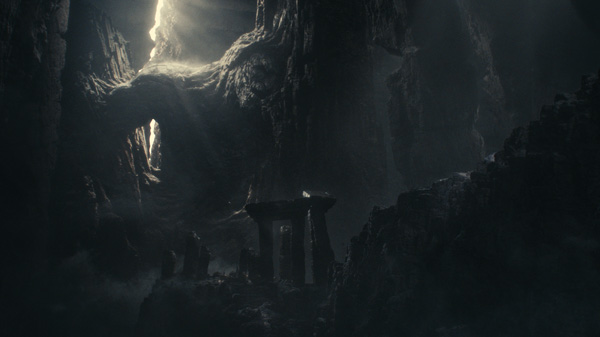 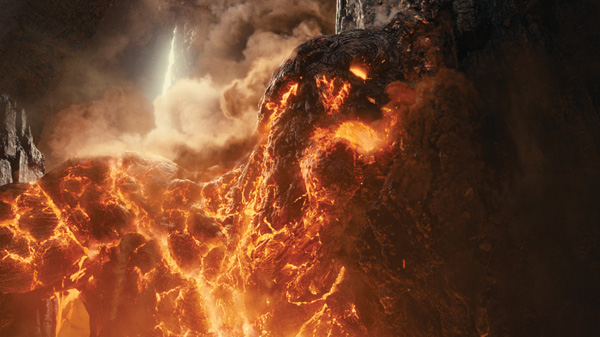 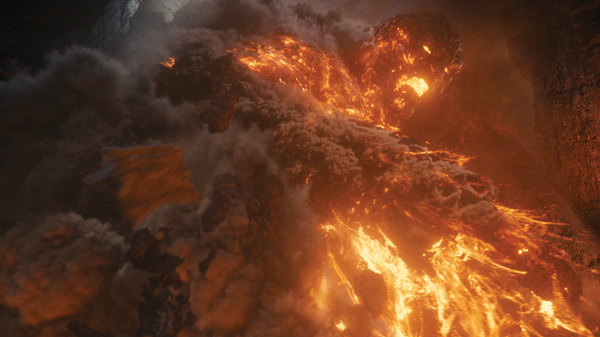 |
| Mountain Man The size of Kronos and his integration into the environment gave rise to concerns that he may not be recognised readily enough by the audience. Deciding on animation style and speed was another challenge. How to both match the massive scale and communicate the drama of the story – at the same time? They kept his actions fairly slow but took care that Kronos should never appear to be moving in slow motion by including other recognisable action in the frame, moving at normal speed. In fact, in their original brief, Kronos was intended to be virtually static – he wasn’t expected to free his hand, for example, to crush the island. But at a certain point in the cut, the director felt a lack of tension in the story as Perseus tries to free Zeus. The team had already gone a certain distance on their development of Kronos by this time, but Jonathan worked on the previs himself, using a model Method supplied, and built the main shots in Maya including camera moves. It only remained for the artists to finesse the looks. The director’s knowledge and ability in visual effects and software was sometimes a double-edged sword. Olivier explained, “On set, what he has in mind may take a couple of hours to achieve, but afterwards when perhaps 100 or more shots arrive in the studio where over a hundred artists are working, the post is simply going to take time. Nevertheless, having his previs definitely helped our discussions about his vision and what he was expecting to see.” |
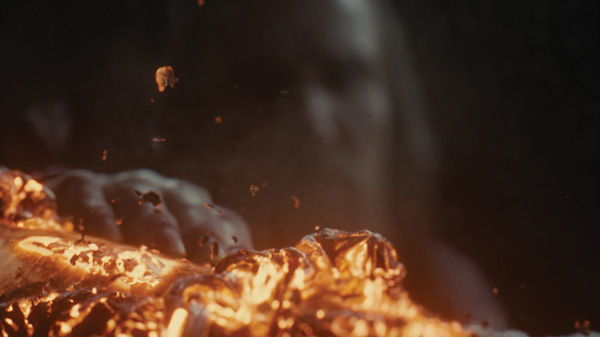 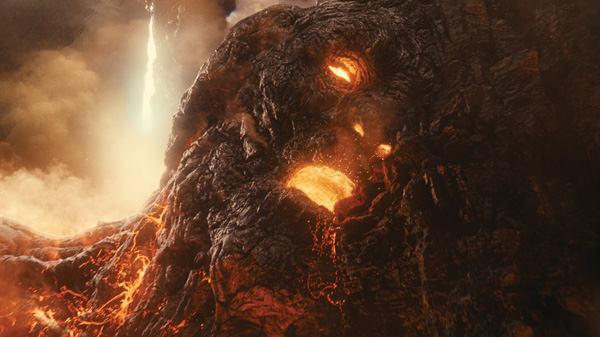 |
| Inner Body At the beginning, because Kronos was going to be static, Method had concentrated on adding textures and the lava erupting from the cracks in the model’s surface. But when the motion was also required, any textures or displacement used on the surface would be subject to stretching. Therefore, they built an inner body composed of magma, plasma and lava and then, on top of this, they rigged outer pieces that worked the way tectonic plates work on the surface of the earth. These plates could be controlled and scaled up or down as if the magma were heating the cooled rock on the surface from inside. This also gave the feeling that the rock wasn’t stretching as it moved – the viewer only sees the cracks opening, driving the eruptions and other CG effects along with the smoke and falling dust. References for these surface looks include the surface of the sun, which has flows moving in multiple directions. They looked at footage of volcanic eruptions and lava flows as well, of course, although these often lacked the scale of the Kronos model and the camera angles they needed to achieve. They tried also to maintain accurate, consistent parameters within the systems but many shots needed tweaking to make sure people understood Kronos visually. “We worked on Kronos’ exterior in ZBrush using a low-resolution, low polygon model created in Maya. You continue building up the polygons in ZBrush but the output is the low-res model with a map for polygon displacement published as an asset. In Maya, we use the low resolution models for the shot layout, and publish the positions for all models as well. Then everything was gathered in Houdini where we lit and created effects on top, and the scene was rendered in RenderMan, which takes the low-polygon output and map and renders out the image.” |
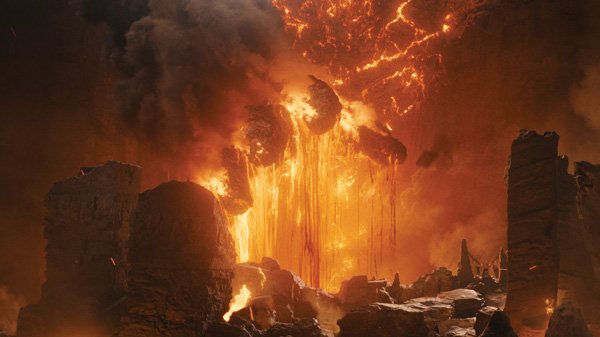 |
| Fire and Ice The collapse of the mountain called for the development of proprietary tools. The first challenge was simply deciding how a collapsing mountain – not something many people have ever seen - should be represented on screen. What would a suitable reference be? They considered explosions in quarries but, again, the footage they found never had the right scale or portrayed the collapse clearly enough. The most useful reference turned out to be the collapse of a glacier. The texture and material qualities of the ice, multiplied many times, has a rock-like nature as it collapses. The large pieces fall first, breaking up against each other until they become a fall of heavy dust and resembling a liquid in the end. They discussed these looks with Nick Davis who agreed it was the best way to show the scale. They designed the first, large pieces on the model of the mountain by drawing maps to use in a custom tool written to fragment it, using the information to outline those pieces and build corresponding volumes inside the mountain, which had started as an empty shell. Creating these volumes by hand would have been very time consuming especially since they needed to try different approaches. This tool could build out the interior based on exterior information, matching size, shape and other parameters. Fragmentation Control He said, “Once we had hand-animated those first pieces and were happy with the looks, we returned the simulation to another tool in Houdini that would break the pieces up even further. We then set up the correct timing to mimic what was happening on the glaciers and capture that collapsing feeling. Later on we added particles as everything falls apart and layered in more smoke and dust.” Method’s fire effects were also in demand for transformations and enhancements to the distinctive weapons that each god carries, which glow when they are in use, such as Zeus' thunderbolt, Hades' pitchfork, Poseidon's trident and Ares' hammer. Zeus and Poseidon are also attacked with balls of burning lava, a combination of fire, liquid lava and embers that leave splatters and trails on the ground. Method added explosions to scenes to match practical effects shot on set. Stereo School “Nuke has made it quite straightforward, once you have rendered both eyes of a CG shot, to add 2D elements. You can project the element onto a card, and Nuke will calculate the other eye to match the CG based on the camera imported from the CG render. “In the case of the Kronos shots, we needed to add digital doubles. For example, in a wide shot where Perseus and Andromeda are running, no live action had been shot and in others where Kronos stands at the back behind the main character, the people ranged along the sides are all CG. Because initially Method weren’t expected to complete full CG shots, we had started working with very low-res models suitable for use at long range. “But as the shots progressed, the models needed more detail, textures, and more sophisticated animation and cloth simulations. The production supplied the scans and photography for them, and they added considerably to our work load, but I think the overall effect is worth the effort because of the visual intensity they bring to these moments in the story.”www.methodstudios.com |
| Words: Adriene Hurst Images: Courtesy of Warner Bros Pictures |


















